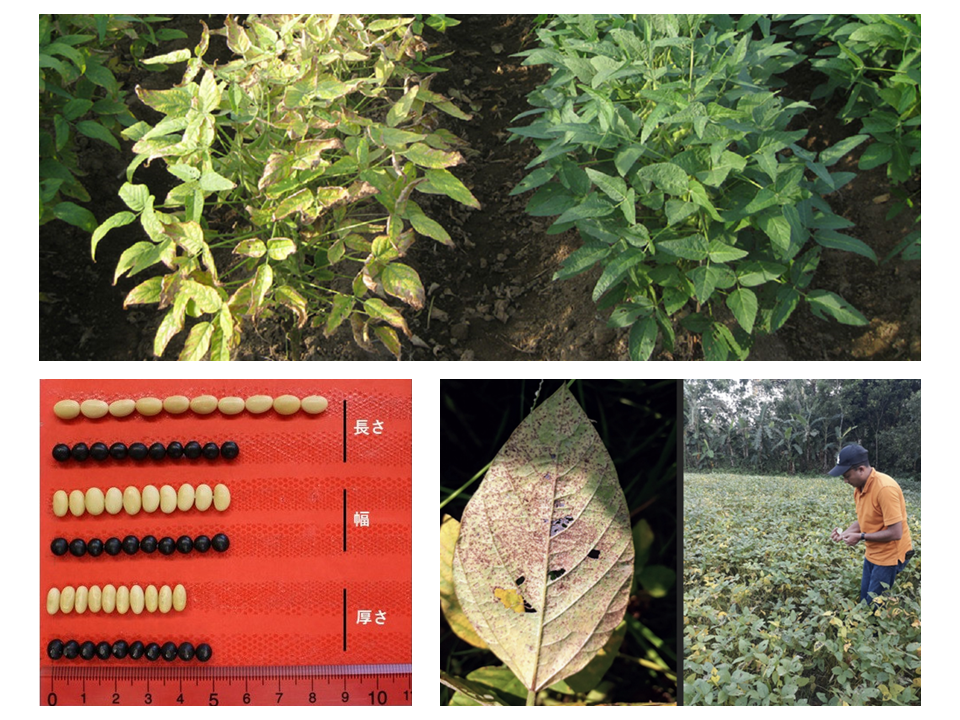Pick Up
710. February 3 is "Soybean Day"

February 3 is "Soybean Day"
Today is "Soybean Day”. It is set on February 3, which is often the day of the Setsubun (seasonal division) festival. As part of a traditional custom, soybeans are scattered to drive away evil spirits and people eat as many soybeans as their age to pray for good health and good fortune.
Soybean is a very familiar crop for Japanese eaten as tofu, miso, soy sauce, natto etc. From a global perspective, soybean is one of the most economically important crops as it is used not only as a raw material for processed foods due to its rich protein content, but also as a source of edible oil and as livestock feed.
In today's Pick Up, we introduce the status of soybean production in Japan and overseas, as well as soybean research at JIRCAS.
1. Global Soybean Status
According to FAO statistics, Brazil ranked first in soybean production in 2021 with 134.93 million tons, followed by the US with 120.71 million tons. Brazil is by far the largest exporter with 86.12 million tons.
Table 1: World Soybean Production (2021)
1 Brazil 134.93 million tons
2 USA 120.71 million tons
3 Argentina 46.22 million tons
4 China 16.40 million tons
5 India 12.61 million tons
(FAOSTAT)
Table 2. World Soybean Exports (2021)
1 Brazil 86.11 million tons
2 USA 53.05 million tons
3 Paraguay 6.33 million tons
4 Canada 4.50 million tons
5 Argentina 4.28 million tons
(FAOSTAT)
2. Soybean Status in Japan
According to the Ministry of Agriculture, Forestry and Fisheries, the self-sufficiency rate for soybeans in FY2021 (estimate) is 7%. Most imported soybeans (93%) are used for oil and feed, and the self-sufficiency rate for food, excluding oil and feed, is 24%*. These facts indicate that both stable production of soybeans for oil and feed produced overseas and improvement of productivity and quality of domestically produced soybeans for food use are necessary.
* Situation surrounding soybeans (Ministry of Agriculture, Forestry and Fisheries, December 2022) https://www.maff.go.jp/j/seisan/ryutu/daizu/attach/pdf/index-13.pdf
JIRCAS conducts research and development with domestic and foreign research institutes, and is engaged in research aimed at improving the stable production and productivity of soybeans, as well as research on genetic resources and markers that can be used for breeding to improve quality.
We introduce here JIRCAS research on soybean published in the Research Highlights 2021.
3. JIRCAS Soybean Research (from Research Highlights 2021)
To ensure stable soybean production, it is important to develop soybeans that are tolerant to environmental stresses. Drought significantly reduces productivity, but by utilizing deep-rooting soybeans, for example, stable production and improved productivity can be expected.
Research Highlight 1: Identification of loci involved in root length that contribute to the improvement of soybean root systems
The soybean variety "Fendou 16" has a long primary root. A well-developed root system not only has better adaptation to the environment, but also absorbs more nutrients from the soil. The information on the loci involved in the primary root length identified in this study can be used for genetic improvement of soybean root systems.
https://www.jircas.go.jp/en/publication/research_results/2021_b01
Soybean seed size is an important factor in determining yield. Shape is also important in terms of appearance quality and processing.
Research Highlight 2: A major and stable quantitative trait locus qSS2 for seed size and shape traits in soybean
In this study, a region of DNA (QTL; quantitative trait loci) that is particularly effective in controlling soybean seed size and shape was elucidated. Future improvements in soybean seed size and shape can be expected.
https://www.jircas.go.jp/en/publication/research_results/2021_b02
Disease is a major enemy of soybean production. In addition to the development of disease-resistant soybeans, JIRCAS is also analyzing disease-causing pathogens.
Research Highlight 3: Genome sequence of the soybean fungal pathogen, Cercospora kikuchii
Soybean leaf blight disease occurs on leaves, petioles, seeds, etc., and causes yield loss. The genome sequence of the soybean purple seed stain fungus Cercospora kikuchii has been completed and can be used for research on pathogenicity-related genes, etc., and for the development of disease diagnosis technology based on molecular biological information.
https://www.jircas.go.jp/en/publication/research_results/2021_b04
Research Highlight 4: The pathogenicity of Asian soybean rust pathogen in Mexico can be grouped into two broad trends
Asian soybean rust collected from 2016 to 2019 in two Mexican states were divided into two groups that exhibit very different virulence characteristics. Information on distinct geographic differences in pathogenicity can be used to control the disease by introducing rust-resistant varieties.
https://www.jircas.go.jp/en/publication/research_results/2021_b05
Please see also the following articles on soybean research.
Research on Asian Soybean Rust Pathogen in Mexico Wins 2021 PhytoFrontiers Best Student Paper Award
https://www.jircas.go.jp/en/program/proc/blog/20221108
Characteristics of New Asian Soybean Rust Resistant Cultivars Developed in Paraguay
https://www.jircas.go.jp/en/program/proc/blog/20220621
Changes in Virulence of Asian Soybean Rust Pathogen in Bangladesh
https://www.jircas.go.jp/en/program/proc/blog/20220510
Senior Researcher Yamanaka of the Biological Resources and Post-harvest Division is Among the World’s Top 10 Soybean Rust Researchers
https://www.jircas.go.jp/en/reports/2020/r20200806
Registration of Two Soybean Varieties Resistant to Asian Soybean Rust in Paraguay
https://www.jircas.go.jp/en/reports/2019/r20190822
Contributors: KANAMORI Norihito (Information and Public Relations Office); XU Donghe, YAMANAKA Naoki and KASHIWA Takeshi (Biological Resources and Post-harvest Division)
